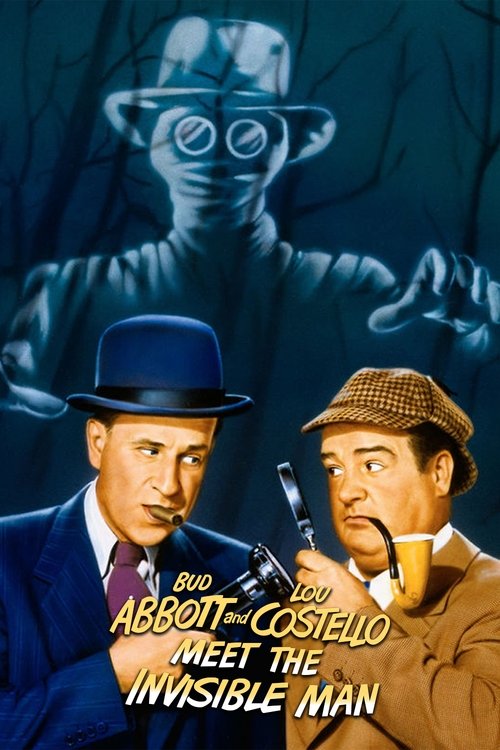I lived with my mother and younger brother for a few weeks at my grandparent’s house in Virginia while Dad was out of the country in Germany, arranging for family housing. Grandpa had a case full of old-time radio show cassette tapes, which is where I was introduced to Abbott and Costello’s classic “Who’s on First” routine. I think I must have been nine years old.
It would be unfair to Bud and Lou to say they never matched the genius of “Who’s on First,” because no one else ever did, either. But Abbott and Costello had a long and successful career, including twenty-eight movies produced by Universal. … Meet the Invisible Man is the second of four of these films to recycle the classic Universal monsters.
The plot is remarkably involved. Tommy Nelson, a former boxer convicted of the murder of his manager, escapes prison and flees immediately to Doctor Gray’s house. Dr. Gray is trying to make the invisibility serum safer to use, but Nelson doesn’t have any time to waste and injects himself with it while Dr. Gray back is turned. It turns out that Nelson’s manager was murdered by mob elements, and then framed for the murder himself. But the invisibility serum turns people megalomaniacal, so he needs the help of two recently-licensed private detectives (Bud and Lou) to clear his name and keep him sane.

Abbott and Costello’s routine followed the smart straight-man, dumb funny-man comic duo that used to be pretty common. What’s not clear from the classic Who’s on First routine is just how abusive Bud Abbott’s stage character really is. Abbott is supposed to be smart, but he’s also vain, arrogant, self-centered, and dismissive. In … Meets the Invisible Man, Bud is constantly trying to double-cross Nelson in order to get the reward money. Lou, on the other hand, is primarily concerned with self-preservation.
… Meets the Invisible Man is a perfectly pleasant watch. That might sound like damning with faint praise, but many nights either my partner or I have too few firing brain cells left to watch anything particularly challenging. Even if you’ve never seen this movie before it will feel very familiar. Lots of similar material shows up in sitcoms or old Scooby-Doo episodes.
There’s not even much here to cringe about, which is an improvement on some Abbott and Costello films. Hold that Ghost, released in 1941, leverages some unsettling racial stereotypes. About the worst we get here is the occasional mild fat joke lobbed at Lou’s expense.

Claude Rains — the original Invisible Man — is not involved in this movie, although the effects coordinator from several other Invisible Man movies is also responsible for the Invisible Man effects in this one. A fair amount of the runtime is taken up with these practical effects, including watching Nelson get undressed, carrying around a cigarette, and so on.
William Frawley plays a grumpy police detective. His was a face I knew I had seen elsewhere. If you’re old enough to have watched old I Love Lucy reruns, he’ll be familiar to you too; he was Lucy and Ricky’s landlord. Entirely unfamiliar to me, but probably pretty familiar to the audience of the day, is Sam Balter. Balter was not only a well-known sports announcer in Los Angeles, but was also a gold-medalist basketball player in the 1936 Olympics.
As old comedy movies go, you could do a lot better and you could do a lot worse — even limiting yourself to Abbott and Costello’s oeuvre. The pacing is often rough; the over-complicated plot means the comic set-pieces have to be linked with lots of exposition. But otherwise the movie is plenty entertaining and doesn’t require much brain-power. Which is really all you need some nights.

